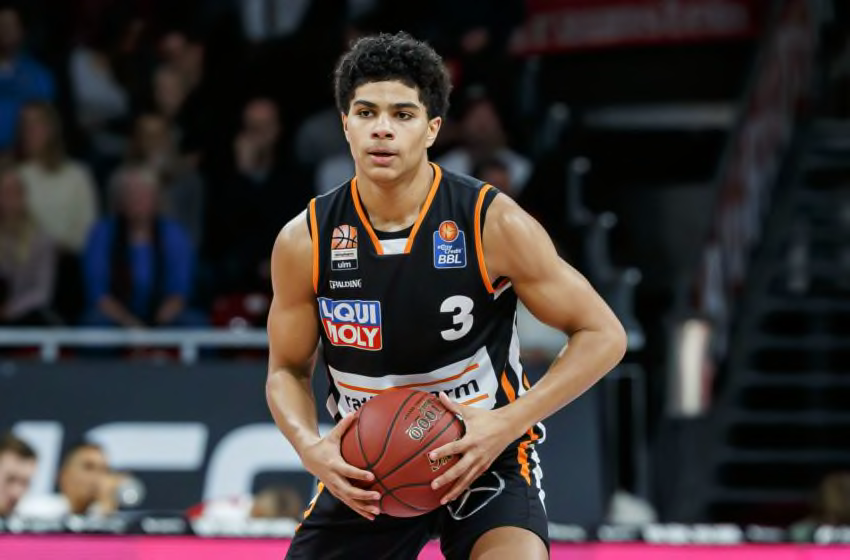Chicago Bulls: NBA draft prospect Killian Hayes could be a good fit
The Chicago Bulls NBA draft spot puts them in a good position to select a much-needed playmaking guard. Killian Hayes might be the guy they’re looking for.
Thanks to the NBA Draft Lottery, we now know that the Chicago Bulls will pick fourth in this year’s draft, which should provide them with an opportunity to address its obvious need for a point guard who can create his own shot and leverage his gravity to conjure up easy baskets for his teammates.
International prospect Killian Hayes could check both of those boxes. While French combo guard’s per-game numbers for Ulm weren’t particularly appetizing (12.8 points, 6.2 assists), he flashed more than enough promise to have, among others, The Ringer’s Kevin O’Connor calling him the best player in this class.
This isn’t to suggest that Hayes is significantly ahead of contemporaries such as Anthony Edwards, Tyrese Haliburton, and LaMelo Ball, but it’s hard not to gin up even a smidge of excitement after glimpsing how the 19-year-old pilots an offense.
Naturally, the passing immediately stands out. Not only does Hayes — who led all of Eurocup in assist percentage in 2019-20 — diagnose defenses like a veteran, but he also has the ability to place to ball in spots where only his teammates can get it.
In the NBA, the best playmakers don’t just make the obvious reads, they also mine seemingly improbable opportunities out of the tiniest of crevices, and Hayes made a habit of doing this during his time overseas, with his 6’5″ frame granting him access to some of those more difficult passing angles.
He also had no problems keeping those guarding him off-balanced with his ball handling. Hayes honed those skills early on by replicating the moves he saw on And-1 Mixtapes and using them against older players and in pickup games in Florida. Calling his dribbling “dazzling” would be a stretch; he instead relies on changing pace to keep defenders on their heels — which also masks his less-than-elite athleticism. If nothing else, he certainly has refined that stepback jumper.
By this point, you’re probably asking “cool, but what makes him different from LaMelo Ball or Tyrese Haliburton, two guards who also possess excellent potential as lanky offensive catalysts?” and you’d be right to ask. After all, those three guards all profile relatively similarly, so what separates Hayes from the others in the NBA draft?
Well, the thing that gives Hayes the leg up is his upside as a shooter off the dribble, which is what any point guard (minus Ben Simmons) who aims to become an All-Star must have. Without that gravity-creating ability, teams can simply sag off of you and clog the passing lanes, mucking up even the most inventive of offenses.
On the surface, Hayes’ lackluster 29.4 3-point field goal percentage with Ulm — and his 21.1 3-point rate in two seasons with LNB Pro A’s Cholet — raises the same red flags as the other guards in this class, but, unlike Ball, his improvements at the free throw line — he shot 87.6 percent at the stripe in 2019-20 — indicate future aptitude from distance (Tankathon projects him to shoot 36.3 percent from behind the arc at the next level). And, unlike Haliburton, Hayes’ more fluid jumper portends brighter expectations as far as his shot creation is concerned.
Hayes has his share of flaws. His lack of lateral quickness brings concern that quick NBA guards will zoom past him and, again, his sub-optimal athletic ability could make him easier to guard in the pros, especially without superb handles (though much of the same was said about Luka Doncic and he’s only become one of the best players in the league in two year’s time).
He also sometimes places too much faith in his ability to fit passes into tight windows, as his propensity for those high-risk plays become turnovers from time to time. And as romantic as it is to project how well he will shoot, that part of his game is still under construction — especially his spot-up shooting, as he only made 22 percent of his catch-and-shoot jumpers last year.
But that’s the thing: none of the players in this class is a sure thing; there are no Zion Williamson‘s to be found on anyone’s big board. That means these teams will have to live with some shortcomings for the hope that these players’ positives will envelop those negatives.
If you’re the Chicago Bulls, is Hayes’ less-than-explosive first step and propensity to play virtually stationary defense enough of as demerit to pass up on the sort of attention-pulling guard this team desperately needs?
Even if the Chicago Bulls bring back defensive stud Kris Dunn, they’ll still need someone who can score and make life easier for his teammates. Even if Hayes turns out to be a younger, slightly better version of Tomas Satoransky he would still give an offense that ranked 27th in pick and roll points per possession (PPP) and 23rd in spot-up PPP a bit of a boost.
Bulls fans have already seen that Dunn (whose offense is as bad as his defense is good), Coby White, and Zach LaVine aren’t equipped to handle that responsibility, and with this supposed new era of Bulls basketball, it would be ridiculous go back to that same combo and expect better than a -3.9 Relative Offensive Rating. At the very least, guys like Lauri Markannen would appreciate having another guard who can deliver the ball right in their shooting pocket.
Drafting Hayes won’t turn this team into a top-10 offense overnight. Again, no one in this NBA draft class is that good and even there was such a transformative player in this class, this roster is too flawed to expect an immediate fortune reversal. But his pliability as a primary initiator on offense and as a floor spacer makes him an ideal fit on a Chicago Bulls team that needs plenty of both.



